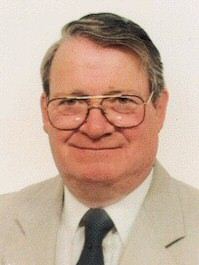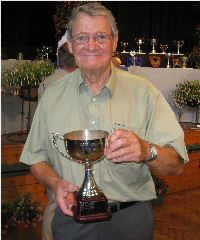Back to the future...
 With
the agility season poised to start again, Lindy Margach spoke to one of the 'founding fathers'
of our sport – the legendary Peter Lewis about what he remembers about the early days, how it
developed and what he thinks is the future. With
the agility season poised to start again, Lindy Margach spoke to one of the 'founding fathers'
of our sport – the legendary Peter Lewis about what he remembers about the early days, how it
developed and what he thinks is the future.
Peter Lewis’s involvement with dog agility began more than
33 years ago when, as chairman of the Kennel Club Working Trials Council, he sat on the working
trials and obedience committee.
At that time, a number of unofficial dog agility
competitions – known as 'dog jumping' - were springing up following the demonstrations at
Crufts Dog Show by Peter Meanwell and his team, who developed this 'entertainment' to fill a
blank half an hour slot before Best In Show 1978.
Q. How did it start?
Hurdles derived from Working Trials were used, the
A-frame, see-saw and dog walk appeared in their current form and were augmented by a window
jump which was quickly abandoned for safety reasons. The strange cross-walk obstacle appeared
subsequently and was put to rest only a few years ago on the grounds of safety and size.
Peter recalls, 'With the initial demonstrations, it was
just a figure of eight course, with the contact obstacles in the corners with the contact
areas always pointing out to the corner. The judge could never see what happened because
he always stood in the middle as the dogs ran around him!
'Eventually it was agreed that we should make rules for
this new activity, including defining the obstacles. They were very basic - no definition of
grades or rules for progression … just ‘yes’ you could do it. Oh, and of course, we changed
the name from dog jumping to Agility.'
The rules came into effect on January 1, 1980.
Spurred on by his involvement in developing the rules,
Peter thought that he should definitely start to get involved with this new 'agility' sport.
And within two months Burridge Dog Training Club was born on his two and a half acres of
ground.
He
remembers, 'After about 18 months, when I was up a ladder painting the eaves of
the bungalow, a young lady came along to classes. It was Lesley Olden who, of course, went on to
become Britain's first ever Agility Champion with her amazing working sheepdog Ag.Ch.
Waggerland Whoosh of Nedlo (aka Loobie).'
The figure of eight course only lasted a few months with
the judge moving from his central position on the course. As the KC rules had allowed the judge
to build the course, 'We soon realised that if the judge placed the equipment in specific ways,
he could move between them without having to be close up to every obstacle, but he would always
need an angle at every obstacle,' Peter says.
 Peter was instrumental in developing the channel weaves to
encourage independent weaving. Peter was instrumental in developing the channel weaves to
encourage independent weaving.
'It was a distinct improvement on shoving the dog through upright
weaves,' he says. Over the years increasingly technical courses meant that the dogs have had
to be trained to an ever-higher standard over the whole course.
'And so agility has gradually got better and better and,
like any sport, has moved on at a rapid pace,'
Peter says: 'Virtually every two or three years there is
a change at the top, with new people coming through. Some people are a one-dog wonder; others
who get to the top can repeat it again and again. All have played their part in taking the
sport forward and now they are absolutely brilliant at the top end – and going at almost
twice the speed we did in the beginning.'
Q. What of the future of agility, then?
'The cloth tunnel may eventually go from the sport,'
Peter thinks. 'If it’s used sensibly with the wind blowing through it, it’s a fair obstacle –
though even then the wind can change during a competition. But to put it against the wind or
at an angle, it will still turn some of the cloth over.
'However, my big worry is that we may go too far with
health and safety issues for the dogs. We have already changed the tyre jump in
the UK to accommodate new dogs, but of course the FCI* still uses the original chain-hung
tyre.'
'Electronic contacts, if they get it right, will
probably have to come eventually,' Peter adds. 'There has been discussion for many years
about the ability of a single judge to get from one end of the dog walk to the other for
every competitor in a huge, fast agility class. Belgium, of course, has a second judge just
for the up contact – an innovation drawn from their obedience judging tradition. I’ve
got no problem with that, except the difficulty of having an additional eight or 10 judges at
a multi-ring show just to judge dog-walk contacts seems to be a waste of man power. My own
view is that, if it were agreed that it is impossible to judge both contacts accurately, I’d
say either don’t judge the up contact at all or extend the contact further up the plank by
creating a second-coloured area to be used for the up contact.'
Q. Will agility ever be recognised as a sport and form part
of the Olympic Games?
'Apparently the reason it is not is because it's not run
like a 'normal' sport but is organised under the aegis of national kennel clubs. The biggest
influence in the world now is the FCI which will only accept pedigree dogs at certain levels,
and that is a big bone of contention, especially from the Olympic organisations. In the early
days, the British KC was not interested in developing the international side of the sport, so
the FCI was the only organisation capable of taking this on world-wide. The differences in
rules are only minor –and not a big problem.'
Q. And what of the future?
'I see some fractions of seconds being knocked off current
winning times – but it will only be fractions,' Peter says. 'The major advances have now been
made and I can’t see how they can go much quicker … tighter handling is now the way forward,
wing wraps have been developed; now we are down to the actual speed of the dog and handler
combination over the ground.'
*FCI is the Federation
Cynologique Internationale, founded in 1911 as an international rule body for dog shows,
including agility. It has 86 member countries but not the UK or USA. While some classes are
open to all dogs, important classes and the World Championships are restricted to pedigree dogs
including a number of breeds not yet recognised by the British KC.
'I was pleasantly surprised when the FCI accepted the
European Open Championships as being truly open and we have to be thankful for small mercies,'
Peter adds. 'As to the Olympics? I think it will come, but when?'
 About the author... About the author...
Lindy
Margach, recently retired as an
agricultural journalist and PR consultant, lives in Surrey with her 'pack' of five - the four
lovely Labradors Shannon, Bracken, Ree and Hobi, plus the latest addition, a 'mental' working
cocker spaniel pup. Young Isla (Eceni Moondance) has already started her puppy foundation
training and is proving an apt pupil with great drive but also a penchant for stealing other
puppies' toys and refusing to bring them back!
First published 8 February 2012 |